Periodicals
Periodicals
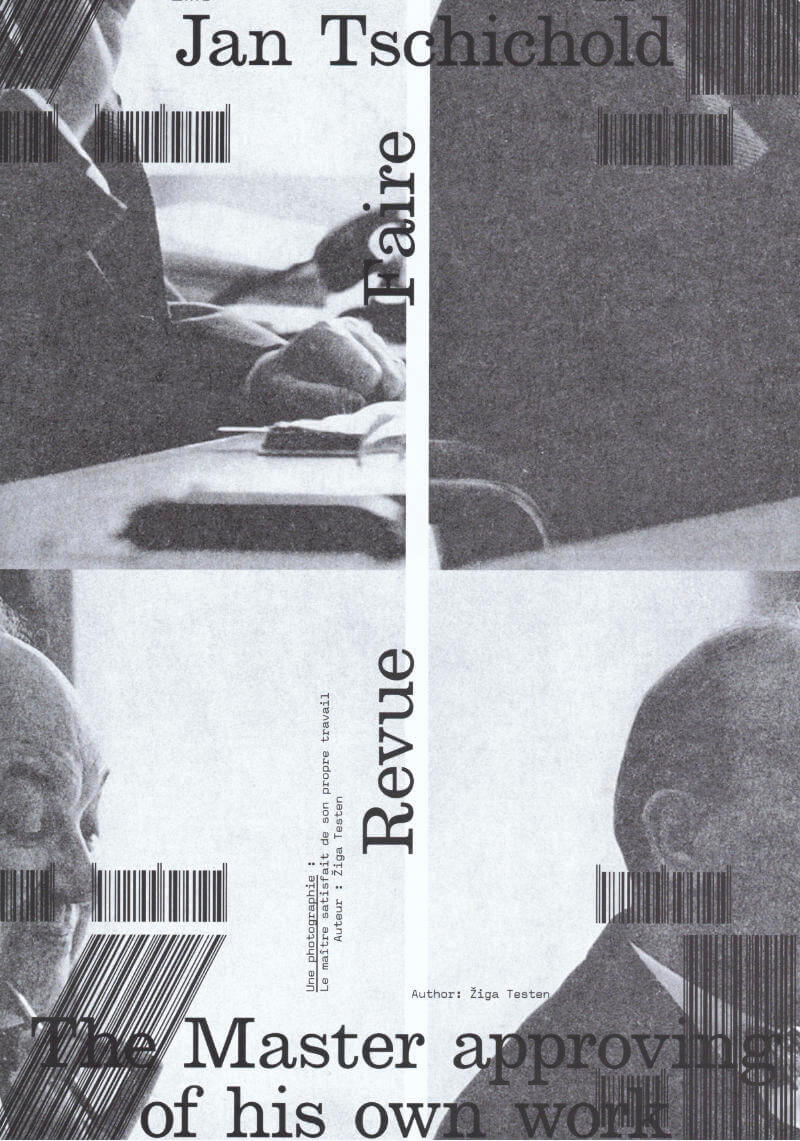
Revue Faire n°23: A Portrait
Design history as an independent discipline and field of study appears to be in trouble. Design historians complain about its diminishing influence within universities due to the ongoing instrumentalisation of higher education. The Eurocentric canon built upon values and methods adopted from art and architecture history has been contested by decolonial theories. And finally, it appears that the trust in the institution of ‘history’ itself and its meta-narratives has eroded.
A discipline that was once considered to provide reflection on what came before and guidance on what could come to be—under the auspice of a grand narrative of continuous progress—has been replaced by modest narratives, social anthropologies, and claims of the ‘end of history’.
In this article, I rummage through the ruins of design history and try to unpack what it was that we once considered design history and our design history canon, how we wrote about it and to what end. In particular, I focus on this one image: a portrait photograph of a well-known historical figure, the designer and typographer Jan Tschichold. How is it used? And what stories do we tell about it?
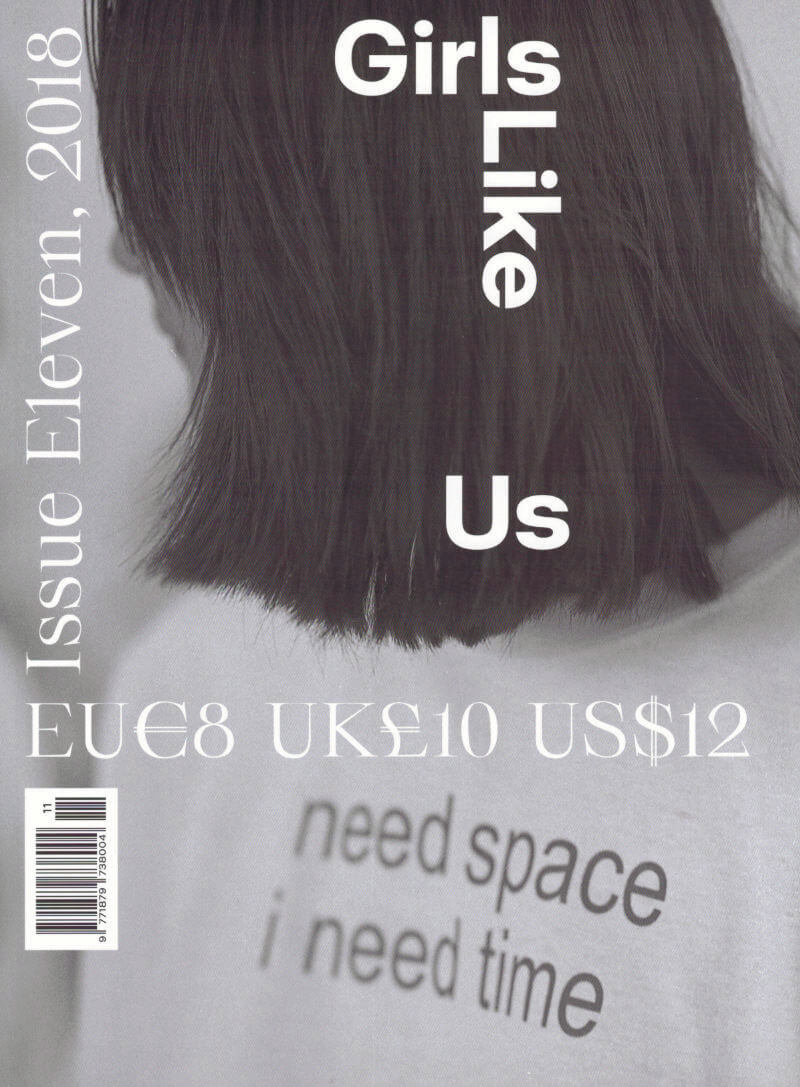
Girls Like Us #11 - Economy
Jessica Geysel, Sara Kaaman and 2 more
Framed as inescapable, indescribable, uncontrollable and essential, economies are everywhere. Oppressive and enabling, lucrative and undervalued, there are economies that trade our emotional labour, desires, love, fertility, time, minds, queerness, politics and clicks. There are economies that we can control and that control us, and those that we can subvert to serve our collectives. A mark, a yen, a buck or a pound, in a conversation with a cat, an app-enabled journey through a rainy Shanghai night, in the margins between intimacy and power, in the kitchen, with your record collection, under the tip of the iceberg, at the foot of a tower she built, dancing at the lesbian bar.

Girls Like Us #10 - Future
Jessica Geysel, Sara Kaaman and 2 more
We want a future outside of straight time. A future in which all our friends and lovers and their lovers are coming over for dinner around a table we built together. We want a future that is fair, fun, furry, fabulous, fierce, free and not fucked up. We want futures.
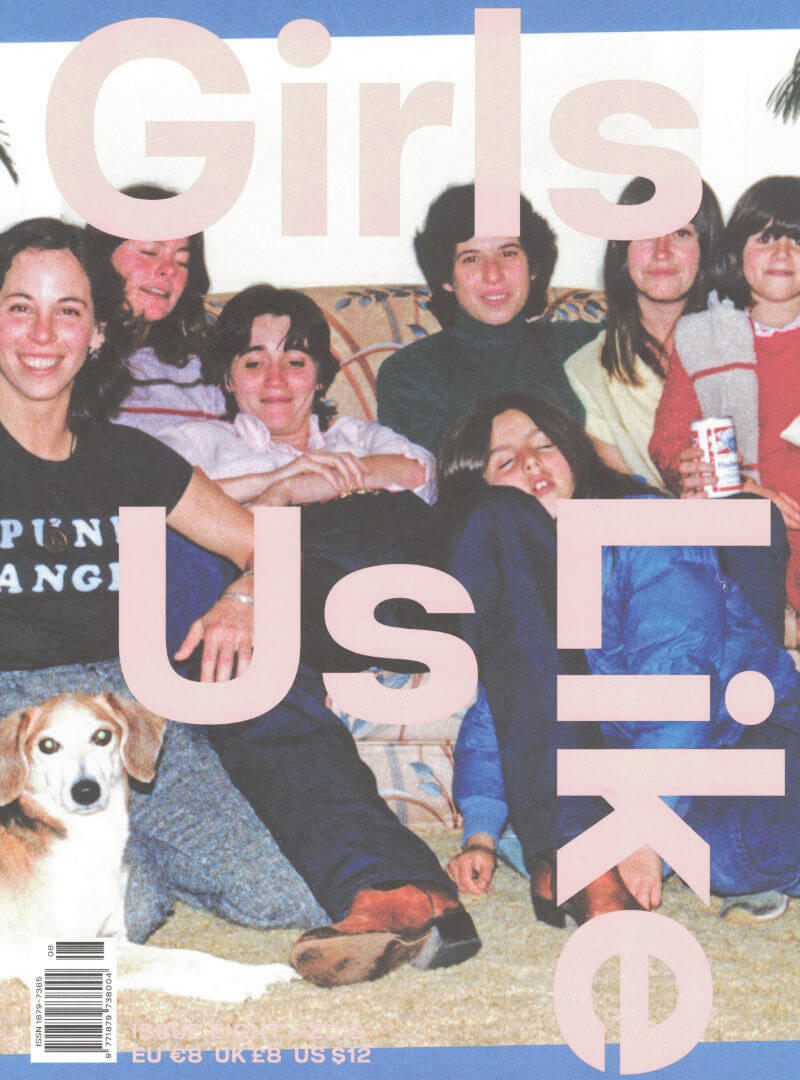
Girls Like Us #8 - Family
Jessica Geysel, Sara Kaaman and 2 more
Dear Lovers, Sisters, Brothers, Mothers, Adopted Aunts, Long Lost Fathers, Half-cousins, Wives, Black Sheep and Partners In Crime
As you know, we have a soft spot for collectives, collaborations, friendships and support structures. People doing things with other people: loving, working, organizing, living. These strategies for surviving together form an underlying thread throughout all our issues. This time we wanted to look more closely at one way of naming these friendly constellations: FAMILY.
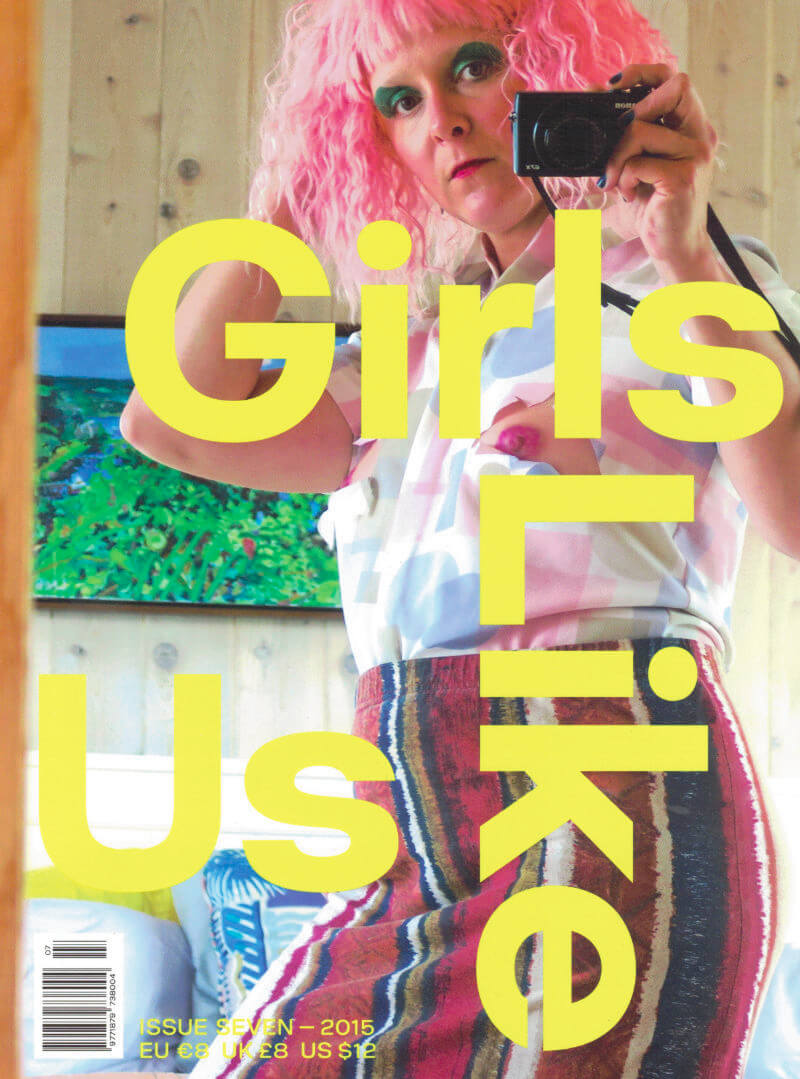
Girls Like Us #7 - Body
Marnie Slater, Katja Mater and 2 more
120 pages exploring the body and bodies, inside out and outside in. Bodies that dance and move. Bodies making waves. Body double. Bodies at work and working with the body. Using the body as an instrument. The body as medium and massage of touch and being touched. The single, singular body as the very basis for a ‘we’.
Interviews with image ingenue K8 Hardy, filmmaker Babette Mangolte, writer Jina Khayyer and documentarist Mariah Garnett. Essays by Derica Shields and Crystal Campell. Plus 7 Q&A's with healers, herbalist and modern witches. Beautiful bodily artists series and last but not least – horoscopic aphrodisiacs.

Girls Like Us #6 - Secrets
Jessica Geysel, Sara Kaaman and 2 more
A secret can be a private space for self-creation – or a shared site of pleasure.
We explore secrets in a plethora of forms and contexts. From layered accounts of mediaeval ecstasy to the unexplored sensory experience of smell. From camouflaged play to queer readings of astrological charts and the hidden history of house music. From a very analog point of view to the outskirts of the internet.
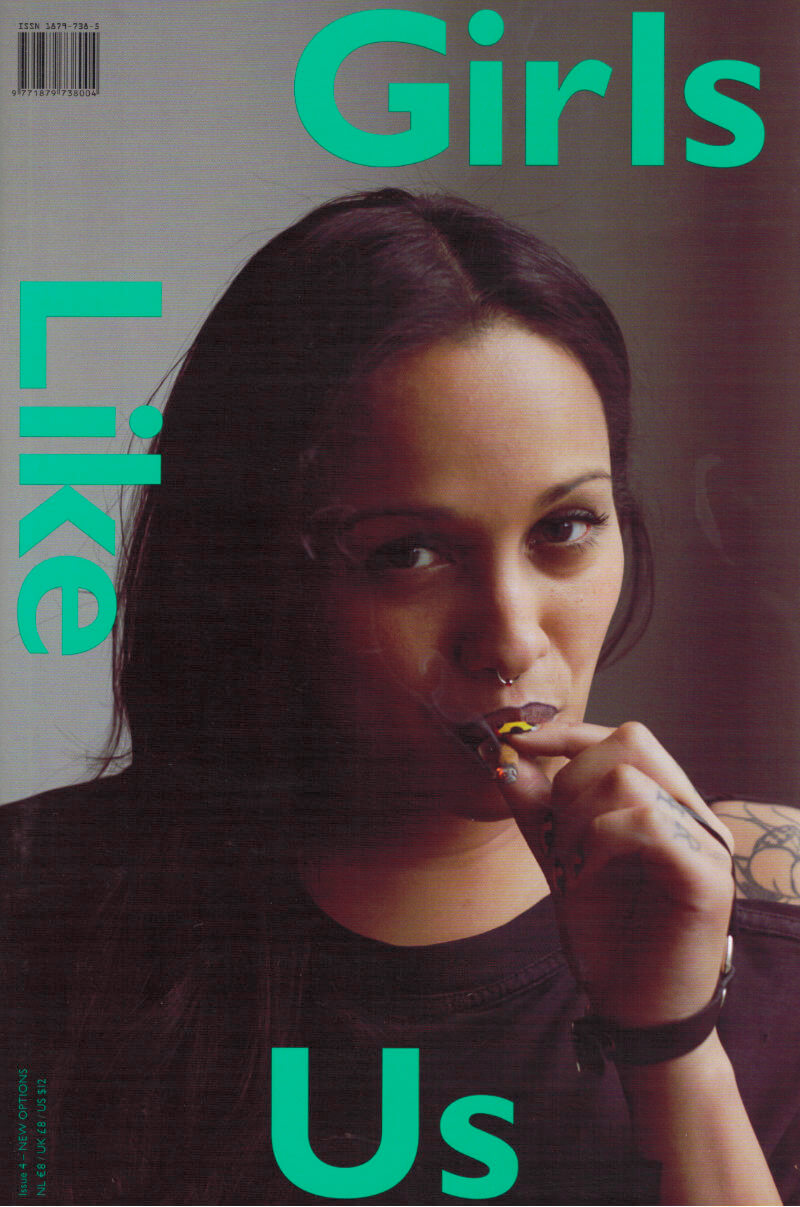
Girls Like Us #4 - New Options
Jessica Geysel, Sara Kaaman and 2 more
These days, if you call someone to go for a drink or a walk in the park, the obvious answer is: 'Sorry, I'm too busy'. Too busy with what? What do you do all day in your studio or office, bar or dancefloor, spending precious time on 'work'? And what makes it different from labouring? Do we slave for money – or no money – building on a system that is doomed to collapse? Or do we build on a new future where work and play are equal? When we work on our own initiatives and with a self-generated goal, would that still be called work? In this issue: other voices, other routes.
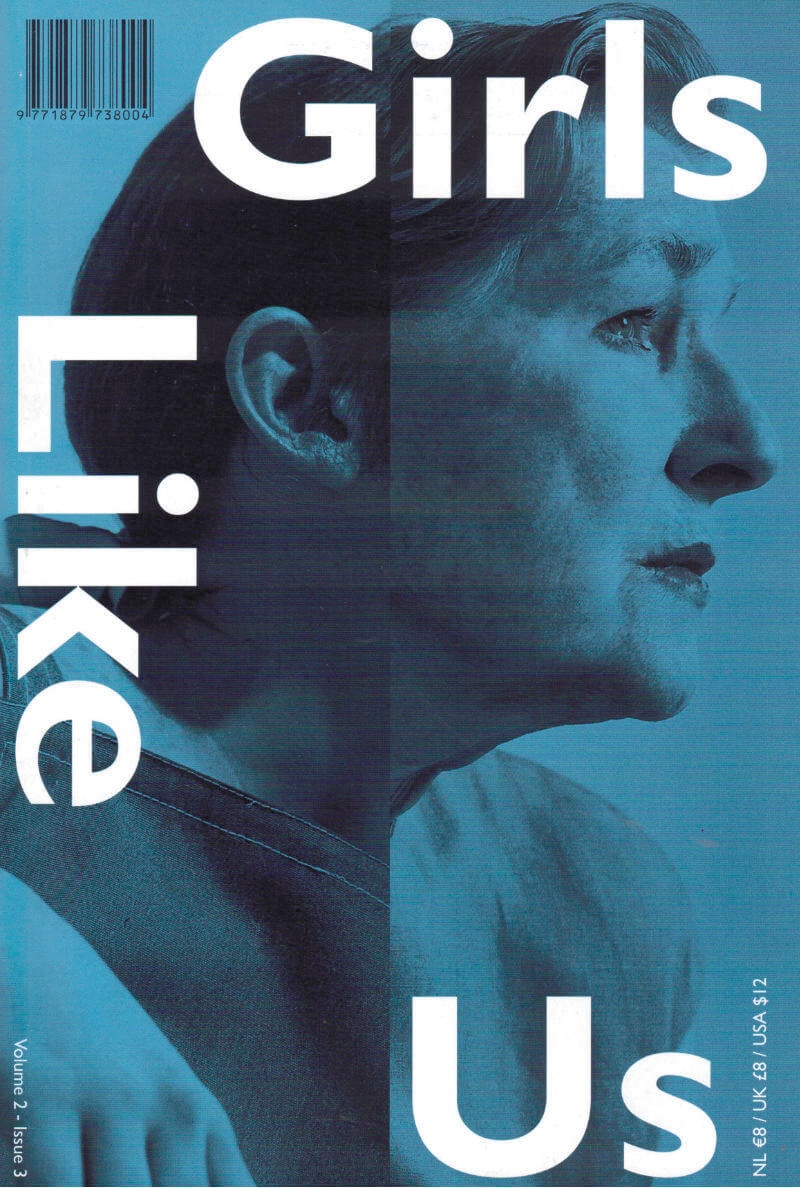
Girls Like Us #3 - Generations
Marnie Slater, Katja Mater and 2 more
Featuring Alice Carey, Anna Franceschini, Lizzie Fitch, Devin Blair, Kim Gordon, Annika Henderson, Melanie Bonajo, Marie Branellec, Elizabeth Orr, Holli Smith, Joke Robaard Litia Perta and Marie Karlberg.
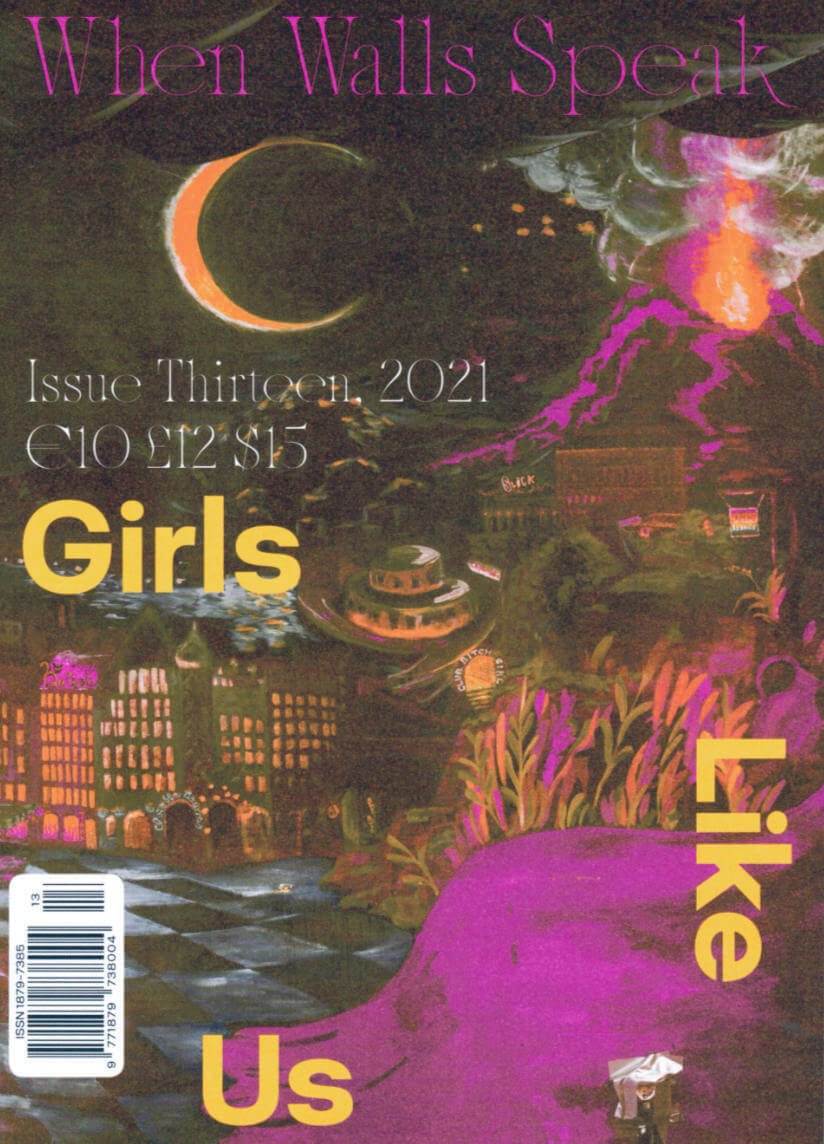
Girls Like Us #13 - The Club Scene
There can never be enough queer spaces, and the club is as good a place as any to begin an exploration. For generations, the club has been a space of legend, gossip, hearsay, and queer history, a place to gather and build community, to feel safe and experiment. The editors of ‘Girls Like Us’ decided to make a guest-edited issue centred around queer architecture back in 2019, long before the pandemic hit. They found the Swedish queer art and architecture collective MYCKET to fill this role, and later also realised how much club spaces were missed in pandemic times. Because, missing clubbing is one thing, but not being able to dance is something else entirely.

Another Gaze Journal 04
Including essays about Madeline Anderson, Lorenza Mazzetti, Laure Prouvost, Ben Rivers & Anocha Suwichakornpong, Agnieszka Holland’s Spoor, Susan Sontag’s filmmaking career, Storm De Hirsch, Zia Anger, Ashley Connor, Bruce LaBruce, Pina Bausch/Chantal Akerman, Magdalena Montezuma, Rebecca Horn, Anne Charlotte Robertson, Zhu Shengze, Beatriz Santiago Muñoz, Maya Da-Rin, Camila Freitas, Gong Li
An in-depth Afro-Brazilian roundtable with Tatiana Carvalho Costa, Janaina Oliveira, Everlane Moraes and Kênia Freitas; sections on Kira Muratova and Anne Charlotte Robertson; essays on subtitles, diffractive cinemas, ecocriticism/the anthropocene, literary adaptations, intimacy coordinators, strike on film, representing the internet,
Interviews with Betzy Bromberg, Zia Anger & Ashley Connor, Brett Story, Amandine Gay, Andrea Luka Zimmerman & Therese Henningsen
Experimental criticism from Kathryn Scanlan, Jen Calleja and Elissa Suh.
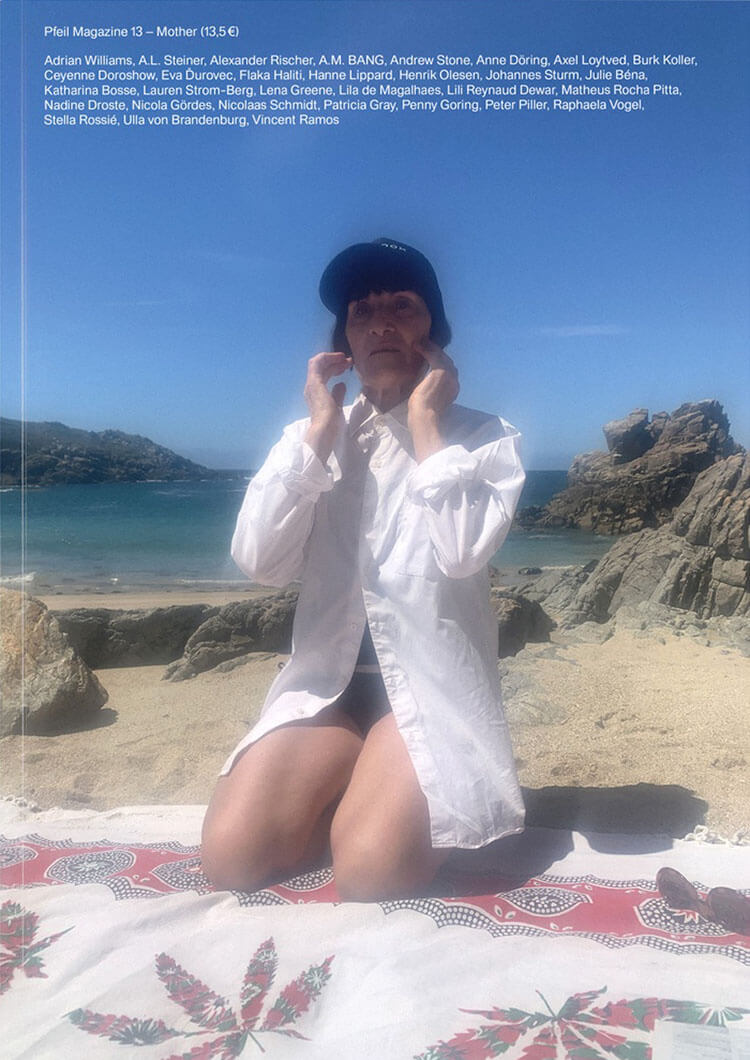
Pfeil Magazine #13 – Mother
The notion of a mother seems simple enough. But just one shy cut beneath the surface lies a multitude of facets, problems, questions, contradictions and wonders all connected to the idea of maternity. Biologically speaking, every person has a mother; perhaps it is the one fact we all have in common. Nevertheless this issue, dedicated to Mother, raises more questions than it is able to answer. Precisely because everyone appears to understand what a mother is, many crucial aspects of the topic are never questioned and are instead taken as a given. Is a mother defined by just having a child, or is it a child that defines the mother? Can we look at the mother without assuming womanhood? Can we untie the gendered attributes bound to the role of a mother? And what exactly are the notions of gender and sex that are connected to the common idea of motherhood? Where do they stem from? What kind of social, biological and economic pressure do mothers and potential mothers face?
In this issue, we explore alternative family structures and how responsibilities of parenting might be shared; prevailing working conditions for mothers in the arts; difficulties, challenges and prejudices mothers face in their professional lives, and what an ideal work environment might look like. Simultaneously, this issue deals with disappointments and unfulfilled expectations in the mother-child relationship, and again at that relationship in the social context. We picture the past and the present in the process of envisioning what maternity could look like in the future
Contributors
Adrian Williams, A.L. Steiner, Alexander Rischer, A.M. Bang, Andrew Stone, Anne Döring, Axel Loytved, Burk Koller, Ceyenne Doroshow, Eva Ďurovec, Flaka Haliti, Hanne Lippard, Henrik Olesen, Johannes Sturm, Julie Béna, Katharina Bosse, Lauren Strom-Berg, Lena Greene, Lila de Magalhaes, Lili Reynaud Dewar, Matheus Rocha Pitta, Nadine Droste, Nicola Gördes, Nicolaas Schmidt, Patricia Gray, Penny Goring, Peter Piller, Raphaela Vogel, Stella Rossié, Ulla von Brandenburg, Vincent Ramos.

HOW TO BECOME A MOTHERFUCKINGELEGIST
how to become a motherfuckinelegist est une revue créée par un collectif de gouines & féministes à Paris. Elle publie les recherches menées pendant les workshops d’écriture & traduction : How to become a lesbian. Ces ateliers sont gratuits et se déroulent toutes les deux semaines à Paris, en non-mixité (pas d'hommes cis).
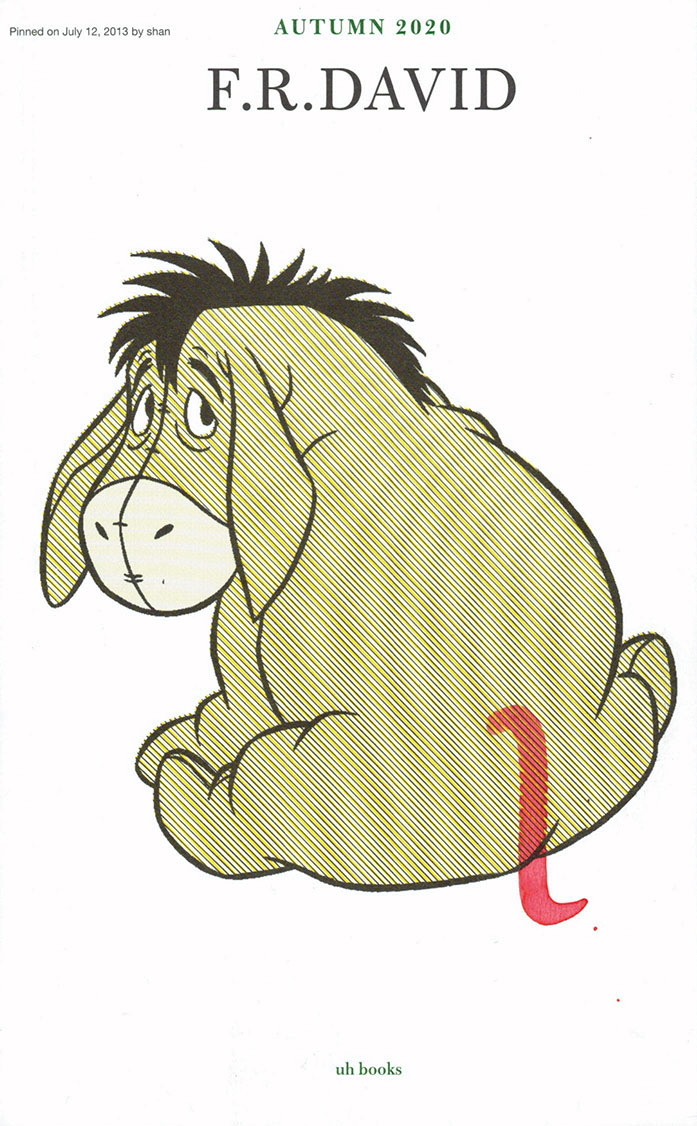
F.R. David - Correctional Facility
F.R.DAVID is a typographical journal, dealing with the organisation of reading and writing in contemporary art practises. The 20th issue, “Correctional Facility” is edited by Will Holder paying attention to difference; and transformations between
accident⎱design 249
acorn⎱oak 293–94, 297–98
adult⎱child 95, 139, 207, 308
alphabetic⎱postliterary 3
alphabetic⎱postalphabetic 3, 5
alphabetic⎱analphabetic 5
analytic⎱linguistic 298
ankh⎱kiss
angles⎱angels 162
aristocrat⎱ass 12
ass⎱man 28
aye⎱eye 160
bad⎱good 130
(outstandingly⎱remarkably)
before⎱after 19, 49, 51, 158,
201, 263, 305
bitter⎱sweet 65, 163, 217
both⎱and 8, 119, 123, 160, 173, 180, 245, 292, 298
cart⎱horse 2, 9
coming into being⎱passing away 318
communism⎱democracy 319
composition⎱improvisation
163, 168, 170
concrete⎱abstract 288
dark⎱light 43, 64, 127, 223,
261, 300, 309, 316
diegetic⎱non-diegetic 145, 193
dropped out⎱drop doubt 160
either⎱or 6, 14, 39, 43, 54, 85, 119, 120, 132, 195, 223, 249, 288
emotional⎱intellectual 297
enthusiastic⎱tempered 13, 78, 205
ἕν καἰ τὀ πᾶν⎱one and all 224
everything⎱fragment 33, 138
everything⎱all things 218–22
experience⎱attention 39, 40, 65, 254–5
green⎱blue 127
high modernism⎱post-structuralist⎱postmodernism 165
radical modernism⎱modernism⎱
postmodernism 4, 164–66
I⎱sigh 160
image⎱word 6, 72, 316–18
Isis⎱Isis 226
jar⎱jars 76, 158, 159
left⎱right 7, 28, 127, 217
meaningful⎱meaningless 258
oak (a⎱ok) 290, 293–94, 297–98
orality⎱textuality 3, 264
phoneme⎱letter 180
phonetic⎱ideogrammatic 297
shit⎱gold †
signal⎱noise 39, 40, 65, 254–55
sweat⎱tears 292
tail⎱bell-rope 151, 154
thesis⎱antithesis 322
written⎱unwritten 158, 296–97
vowel⎱consonant 180–82, 292
we are⎱we ain’t 93
white pawn⎱white pawn 224
word⎱world 8, 12, 138, 160, 165, 166, 180, 183, 260, 265, 287, 298, 300, 315, 317
writing⎱nature 27, 44, 83, 120,
121, 126, 166, 183, 198, 203,
219–20, 252, 297, 318–19
Published October 2020.
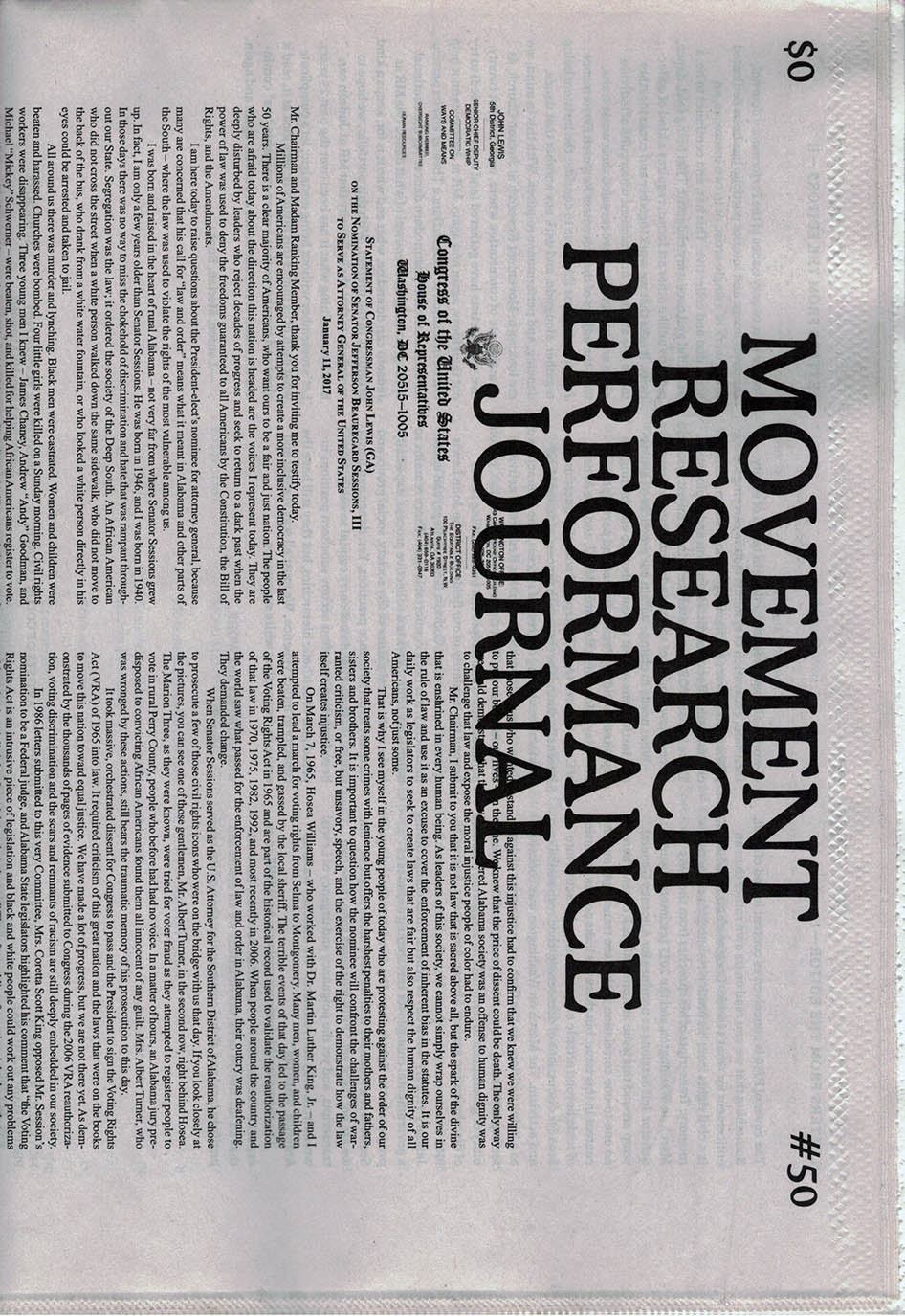
Movement Research Performance Journal
MRPJ - Archive Issues
Different archive editions of the journal available to consult in our space (not for sale). With editions ranging all through the history of the journal.
Available issues :
#03
#05
#14
#15
#19
#20
#22
#26
#50

Movement Research Performance Journal
Issue #52/53 - Sovereign Movements
Movement Research announces Issue 52/53 of its print publication, the Movement Research Performance Journal. For this issue, Sovereign Movements: Native Dance and Performance, guest editor, choreographer Rosy Simas invited writer, Ahimsa Timoteo Bodhrán, to work with her. Together they assembled contributors from Native and Indigenous communities to reflect upon their practices, the historical conditions out of which they operate as well as movement, performance, and choreography as a socio-political project. Just as it is important for physical institutions to acknowledge that they sit upon occupied land of Native and Indigenous people, so too must institutions of history, practice, and epistemology acknowledge their occupation of knowledge and memory.
Throughout this issue, dance and movement is posited as a powerful strategy against settler-colonial mindsets and as an effective tool against erasure of Native and Indigenous cultural traditions. These pages discuss the importance of Native sovereignty and analyze various histories of resistance to settler-colonialism. Artists in the issue propose alternative artistic models to probe the roles of art and artists in society towards a more expansive constellation that fundamentally critiques the Western reward system in culture as well as the often celebrated cult of authorship.
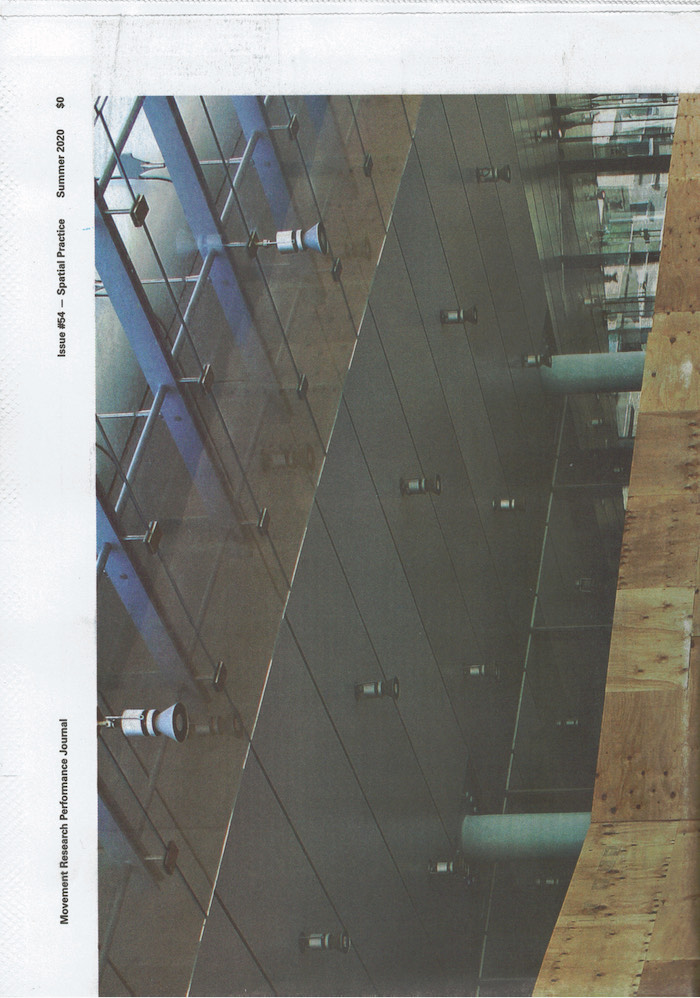
Movement Research Performance Journal
Issue #54 - Spatial Practice
Movement Research announces Issue 54 of its publication, the Movement Research Performance Journal. Continuing to experiment with approaches that engage contemporary choreography and performance through the medium of print—poem, prose, image, interview and a wide range of formats give form to critical and self-reflexive discourses and material histories. Movement Research Performance Journal acts as a site of convergence between publication, editors, writers, designers, and artists to consider the place of dance, performance, and choreography in relation to the contemporary moment.
For MRPJ54: Spatial Practice, guest editor, artist Alan Ruiz invited contributors to examine the ongoing legacy of neoliberalism and the cultural production it engenders, specifically focusing on the relation between bodies and the built environment. Contributors have explored the contexts and histories in which we dwell, create, and coexist to interrogate how space is produced both as material and ideology during the hyper-development and hyper-exploitation of the urban environment, predominantly in New York City. Spatial Practice asks: how does this impact the bodies that labor and move to keep the kinetic machine of “progress” moving? Contributions offer multiple perspectives—through a variety of genres—on the ways in which the political project of neoliberalism has, in part, shaped the designation and use of public space as well as enthroned the philanthropic class and the cultural institutions associated with them. Alongside the consolidation of wealth and power, neoliberalism’s underlying insistence on individualism has also reinforced and normalized the braided conditions of capitalist exploitation, structural racism, and patriarchal domination. Unraveling this logic allows us to collectively imagine alternatives to the prevailing systems of property, dispossession, ableism, and incarceration that parcelize existence.
Contributions from:
Critical Resistance, Alan Ruiz, Lluís Alexandre, Casanovas Blanco, Julie Tolentino and Sadia Shirazi, Kaegan Sparks, Martha Rosler, Suzanne Stephens, Joshua Lubin-Levy, Lo-Yi Chan and Tim Hartung, Olive McKeon, Alice Sheppard, Biba Bell, Erik Thurmond, BRANDT : HAFERD, V. Mitch McEwen and Olivier Tarpaga, Sarah Oppenheimer, Jimmy Robert and Mario Gooden, Dominic Cullinan, Angela Davis J. Bouey and Melanie Greene, Lisa Nelson, Diana Crum, Kristopher, K.Q. Pourzal, Jess Barbagallo, John Hoobyar and Simon Asencio, Layla Zami, Cristiane Bouger, Daria Faïn and Marjana Krajač, Germaine Acogny, Helmut Vogt and André Zachery, Milka Djordevich and Tim Reid, Melanie Maar.
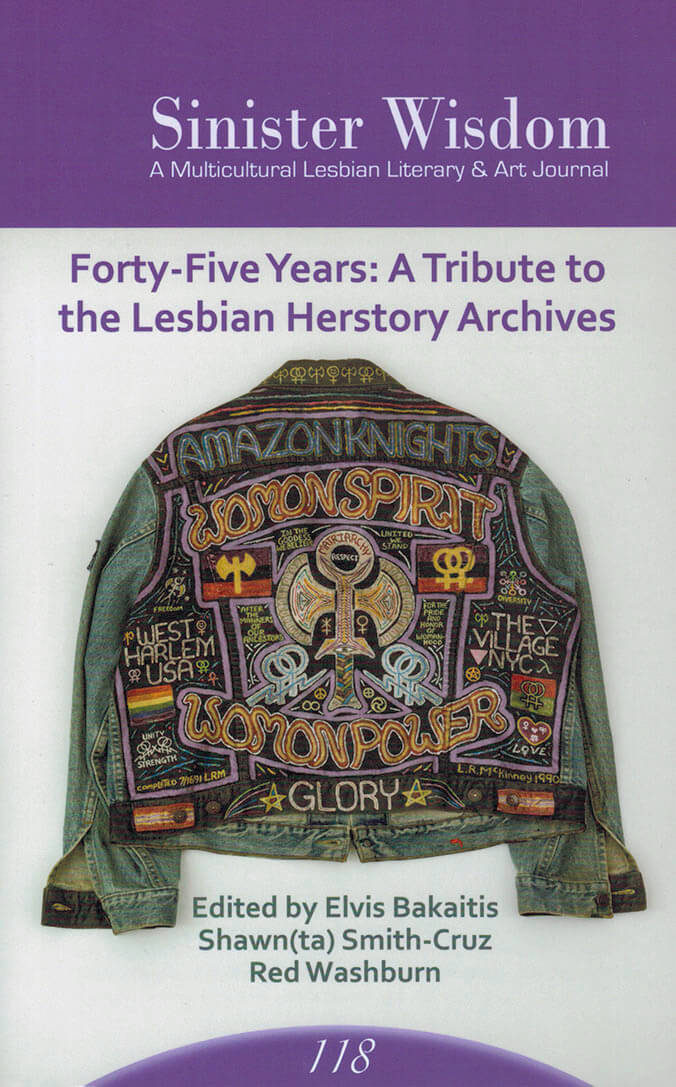
Forty-Five Years: A Tribute to the Lesbian Herstory Archives
Forty-five years ago movements of liberation made possible the birth of a new project in the world, the Lesbian Herstory Archives. In Sinister Wisdom 118 are some of the founding stories, telling what it meant to walk first into an apartment and later into a four-story limestone building, where shame became history, secrets became shared connections and complex lesbian, queer histories were enriched by maintaining intergenerational community.
A grassroots collection, the Archives was intentional about engaging with all facets and complexities of lesbian life, inclusive of diversity in race and gender-identity, from the bar life of the fifties and before, to the lesbian-feminist cultural richness of the mid-twentieth century and beynd, to the gender richness of the tweny-first. This issue honors an Archives that articulates the complexities of how lesbians make our way in the world.

Le Chauffage — Issue #1
Le Chauffage (french for “The Heater”) is an artist-run publication based in Brussels. It is conceived as a cross-continental, community oriented platform. Bringing together the work and writing of artists / friends from different cities, Le Chauffage intends to spark discussions and fuel casual forms of critical discourse.

The Against Nature Journal #1
Aimar Arriola, Grégory Castéra
THE AGAINST NATURE JOURNAL is a biannual arts and human rights magazine exploring “crime against nature” laws and their legacies, in print, in person, and online. Authors and readers from law, activism, social sciences, and the arts are brought together to foster dialogue on sexual and reproductive rights and rethink nature anew.

a queer anthology of healing
a queer anthology of healing is a subtle, devastating mix of cuteness and embarrassment, beauty and confession, magic tricks and pain. The artworks and writings in this collection suggest that healing can be achieved through revelation, invocation, observation and disclosure. It’s a much-needed gift right now. - Chris Kraus
with Clay AD, Harry Agius, Barney Ashton-Bullock, Bodie Bellamy, Jack Bigglestone, Nick Blackburn, Helen Cammock, Charity Coleman, Swithun Cooper, Paul Gabrielli, Evan Garza, Erica Gillingham, Daniel Givens, Pete Hammond, Benedict Hawkins, Georgie Henley, Lubaina Himid, Fanny Howe, Jasmine Johnson, G.B. Jones, Kevin Killian, Wayne Koestenbaum Nic Lachance Olivia Laing, Benedict Leader, Paul Lee, Mary Manning, Ben Miller, D. Mortimer, Monique Mouton, Annie Murrells, Chuck Nanney, David Nas, Isobel Neviazsky,Paul P. , Richard Porter,Peter Scalpello, Hyacinth Schuss, Ryan Skelton, Verity Spott, Edward Thomasson, Timothy Thornton, Declan Wiffen, Ian Wooldridge

Nicole Eisenman
Clotilde Viannay, Nicole Eisenman
L'Incroyable is a monographic magazine dedicated to an artist's teenage years and his cultural background. This third issue proposes an immersion into the young years of artist Nicole Eisenman in New York in the 1980s.
Founded in 2015 by artist Clotilde Viannay, L'Incroyable magazine is dedicated to adolescence and retraces the teenage years of a personality, examining the cultural context of his youth.
The magazine is extended by the “Mini” series. Each book immerses itself in the youth of artists through an interview about their teenage years.
Since the 1990s the American artist Nicole Eisenman (born 1965 in Verdun, France, lives and works in New York) has garnered attention with her figurative paintings that, playfully and with great artistic freedom, cross stylistic and compositional elements from the history of art from Renaissance painting to modernism with comics, slapstick, TV culture, pornography, and subcultural image strategies.
Central to Eisenman's oeuvre is a complex, excessive, drawing-based work that comprises all the classical picture genres as well as a wit formulated between the outrageous and the idiotic. Nicole Eisenman's work is an inspired and gleeful deconstruction of conventions in art and society and it questions social models above all by reversing the clichés of female and male roles. It is about power and powerlessness, about art and commerce, consumerism and sex, about the possibilities made available by professionalism and dilettantism, and how artistic success and everyday life are constructed.
At the same time her work deals with the subsequent question of how the individual and she herself as artist and woman can take up a position within these roles. Eisenman's narratives of grotesque reformulations of social orders, or her depictions of human individuality, are always interspersed with possible failure or scenic breakdown: the pictorial content, the painting procedure, and the message contradict each other, and investigate a state of decline in historical as well as current conventions.
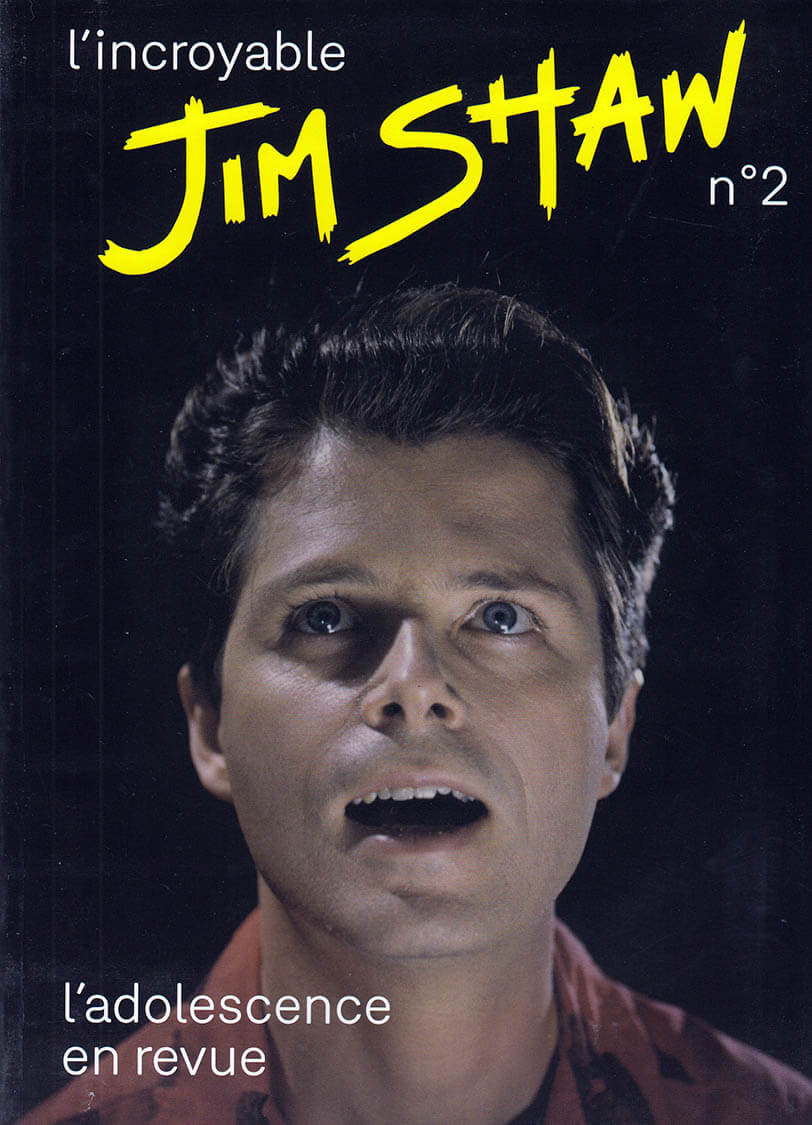
Jim Shaw
L'Incroyable is a monographic magazine dedicated to an artist's teenage years and his cultural background. This second issue focuses on Jim Shaw's Californian youth between the late 1950s and the beginning of the 1970s.
34 contributors—including Jim Shaw, Tony Oursler and Cary Loren—discuss childhood, adolescence, being a student in California in the 1970s, Mike Kelley, comic books, drawing, painting, California, the hippies, LSD, Charles Manson, the Vietnam War, Richard Nixon, My Mirage and Oism, Born Again Christians, catechism, transhumanism, cyborgs, Scientology and the Church of Satan, Terrence Malick, the Beat Generation, counter-culture, Gilbert Shelton, Robert Crumb, Janis Joplin and Basil Wolverton, Michigan, Ann Arbor, proto- punk, Destroy All Monsters, MC5, John Sinclair, and Tiki culture.
Works by Mathilde Agius, Joan Braun, Bertrand Dezoteux, Golgotha, groupe CCC – Alice Gavin and Valentin Bigel and École Duperré Paris students, Jérémy Piningre, Jim Shaw, Pierre Vanni.
Founded in 2015 by artist Clotilde Viannay, L'Incroyable magazine is dedicated to adolescence and retraces the teenage years of a personality, examining the cultural context of his youth.
The magazine is extended by the “Mini” series. Each book immerses itself in the youth of artists through an interview about their teenage years.
Jim Shaw (born 1952 in Midland, Michigan, lives and works in Los Angeles) is an atypical figure in the Californian art world, sharing with Paul McCarthy and Mike Kelley a similar desire to produce an immersive visual oeuvre aimed at exploring the dark side of the American psyche.
Texts by Philippe Aronson, Jacques Barbéri and Yves Ramonet, Claire Barliant, Laura Ben Hayoun, Mathieu Buard, Robert Buchard, Laurent Courau, Michel Croce-Spinelli, Michel Parbot, Jill Gasparina, Étienne Greib, Doug Harvey, Yves-Alexandre Jaquier, Cary Loren, Alex Mar, Robert Somma, Philippe Vasset, Clotilde Viannay, interviews with Jim Shaw, Tony Oursler, Cary Loren, Neil Harbisson, Natasha Vita-More, Gilbert Shelton.

Salvage 8: Comrades, this is madness
The Salvage Editorial Collective on the Covid-19 crisis.
Including: ‘Mothering Against the World' by Sophie Lewis on ‘Momrades’, ‘The Bushes’ a new fiction by China Miéville, ‘Hookers and Other Angels’ photography from Juno Mac, ‘Prepared for the Worst’ by Richard Seymour on Disaster Nationalism, ‘Welfare State Populism and the “Left-Behind Left”’ by Kevin Ochieng Okoth, ‘A Glimmer of a Shell of a Husk’ by Maya Osborne; ‘The Phallic Road to Socialism’ by Sebastian Budgen; A newly translated interview with Daniel Guérin, ‘Nationalism After Coronavirus’ by Sivamohan Valluvan, ‘Striking in Striking Times: Capitalism’s Coronavirus Crisis’ by Gregor Gall, ‘Getting Dressed for a Pandemic’ by Camila Valle, ‘Out of the Iron Lung: A Miasma Theory of Coronavirus’ by Matthew Broomfield.
Poetry by Nisha Ramayya, this issue’s featured poet, and an interview with her conducted by Salvage poetry editor, Caitlín Doherty. Plus the return of the Salvage Editorial Collective perspectives pamphlet, and a postcard.
Salvage is a bi-annual journal of revolutionary arts and letters. Salvage is written by and for the desolated Left, by and for those sick of capitalism and its planetary death-drive, implacably opposed to the fascist reflux and all ‘national’ solutions to our crisis, committed to radical change, guarded against the encroachments of ‘woke’ capitalism and its sadistic dramaphagy, and impatient with the Left’s bad faith and bullshit.
Published June 2020

GF Reader 2
GenderFail Reader 2 is a compilation of four brand new essays written during the pandemic including Small Publishing and Finding Ways to Live, A Touch that You Can Really Feel, Collective Self Isolations: Resistance in the Care of Others and the Violence of Naming. This second printing also has a new essay “Complete Idiots All of Them: Thinking UnFathomable Dreams.
This reader also includes three new poems, Being an Instrument, Douche and Making Friends at 30, by my partner Noah LeBien, who as become such an important collaborator through my work with GenderFail. Noah also expanded their essay, Betraying Authority: Notes on Queer Art that was previously published as a zine.”
Be Oakley, (formally known as Brett Suemnicht) Born 1991 in Clearwater, Florida; is an writer, facilitator and publisher based in Brooklyn, NY. Oakley's projects looks to what Fred Moten calls "the politics of the mess" by framing their identity as a white non-binary queer person in its intersections with failure and internationality. In 2015 they started GenderFail, a publishing and programming initiative that seeks to encourage projects that foster an intersectional queer subjectivity. Their work has been shown in programs and exhibitions at MoMA PS1 (NYC), the Studio Museum of Harlem, The International Center of Photography (NYC), Vox Populi and Sediment Arts. Their publications can be found in the library collections of The Museum of Modern Art, The Whitney Museum, The Met Museum, The Center for Book Arts and many others.